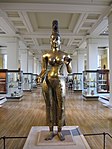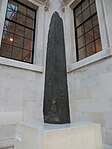Lion of Knidos
1858 archaeological discoveriesAncient Greek and Roman sculptures in the British MuseumArchaeological discoveries in GreeceHellenistic sculptureMarble sculptures in the United Kingdom ... and 2 more
Sculptures of lionsStatues in London

The Lion of Knidos is the name for a colossal ancient Greek statue erected near the ancient port of Knidos, south-west Asia Minor (now near Datça in Turkey). Although there is some debate about the age of the sculpture, in general, scholarly opinion dates it to the 2nd century BC. Since 2000, it has been prominently displayed on a plinth under the roof of the Queen Elizabeth II Great Court because soon after it was seen by British archaeologists in 1858, the statue was taken by the British to London where it became part of the British Museum's collection.
Excerpt from the Wikipedia article Lion of Knidos (License: CC BY-SA 3.0, Authors, Images).Lion of Knidos
Great Court, London Bloomsbury (London Borough of Camden)
Geographical coordinates (GPS) Address Nearby Places Show on map
Geographical coordinates (GPS)
| Latitude | Longitude |
|---|---|
| N 51.519 ° | E -0.127 ° |
Address
Reading Room
Great Court
WC1B 3DE London, Bloomsbury (London Borough of Camden)
England, United Kingdom
Open on Google Maps









